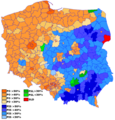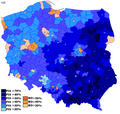The Civic Platform is a centre to centre-right liberal conservative political party in Poland. Since 2021, it has been led by Donald Tusk, who previously led it from 2003 to 2014 and was President of the European Council from 2014 to 2019.
The Polish People's Party is an agrarian political party in Poland. It is currently led by Władysław Kosiniak-Kamysz.

From 1989 through 1991, Poland engaged in a democratic transition which put an end to the Polish People's Republic and led to the foundation of a democratic government, known as the Third Polish Republic, following the First and Second Polish Republic. After ten years of democratic consolidation, Poland joined NATO in 1999 and the European Union on 1 May 2004.

The Social Democracy of Poland is a social-democratic political party in Poland.
Poland has a multi-party political system. On the national level, Poland elects the head of state – the president – and a legislature. There are also various local elections, referendums and elections to the European Parliament.

Parliamentary elections were held in Poland on 23 September 2001. All 460 members of the Sejm and 100 senators of the Senate were elected. The election concluded with an overwhelming victory for the centre-left Democratic Left Alliance – Labor Union, the electoral coalition between the Democratic Left Alliance (SLD) and the Labour Union (UP), which captured 41% of the vote in the crucial lower house Sejm. The 2001 election is recognized as marking the emergence of both Civic Platform (PO) and Law and Justice (PiS) as players in Polish politics, while also witnessing the outright collapse of the Solidarity Electoral Action (AWS) and its former coalition partner, the Freedom Union (UW).

National Party of Retirees and Pensioners is a minor left-wing political party in Poland. The main goal of KPEiR is protecting retired seniors, pensioners and trust-busting. The current leader is former Sejm Member Tomasz Mamiński.

The 2009 European Parliament election in Poland was the election of the delegation from Poland to the European Parliament in 2009 which took place on 7 June 2009. On 13 February the Sejm accepted a proposal for an amendment to the electoral court act to allow voting for the European Parliament election of 2009 to take place over 2 days i.e. the 6 and 7 June 2009. However, on 5 March, the proposal was referred to the Constitutional Tribunal of the Republic of Poland by the Polish President, Lech Kaczyński. The Polish electorate elected 50 MEPs. In the 27 EU Member States, at total of 736 MEPs were elected from 4–7 June 2009.

Sovereign Poland, also known as United Poland, until 2023, is a Catholic-nationalist political party in Poland led by Zbigniew Ziobro. It was founded in 2012, as the Catholic-nationalist split from the Law and Justice, with whom they later formed the United Right alliance in 2014.

Poverty in Poland has been relatively stable in the past decades, affecting about 6.5% of the society. In the last decade there has been a lowering trend, as in general Polish society is becoming wealthier and the economy is enjoying one of the highest growth rates in Europe. There have been noticeable increases in poverty around the turns of the decades, offset by decreases in poverty in the years following those periods.
The Polish Communist Party, or the Communist Party of Poland, is an anti-revisionist Marxist–Leninist communist party in Poland founded in 2002 claiming to be the historical and ideological heir of the Communist Party of Poland, Polish Workers' Party and the Polish United Workers' Party.

Parliamentary elections were held in Poland on 13 October 2019. All 460 members of the Sejm and 100 senators of the Senate were elected. The ruling right-wing Law and Justice (PiS) won re-election to a second term retaining its majority in the Sejm. However, it lost its majority in the Senate to the opposition. With 43.6% of the popular vote, Law and Justice received the highest vote share by any party since Poland returned to democracy in 1989. The turnout was the highest for a parliamentary election since the first free elections after the fall of communism in 1989. For the first time after 1989, the ruling party controlled one house, while the opposition controlled the other.
The United Right was a parliamentary group formed by Jarosław Gowin and Zbigniew Ziobro with their respective parties, Poland Together and United Poland. After their cooperation at 2015 Polish parliamentary election with the Law and Justice party, 'United Right' became a media label for the ruling right-wing political alliance of Law and Justice with its aforementioned partners in Poland.
The Civic Coalition is a catch-all political alliance currently ruling in Poland. The alliance was formed around Civic Platform in opposition to the then-ruling Law and Justice (PiS) party.
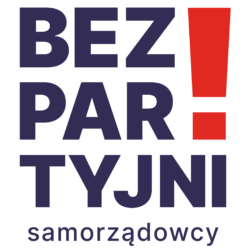
Bezpartyjni Samorządowcy is a Polish political movement. Operating mainly at a regional level in a decentralised manner, it participates in elections as a national committee joining the individual regional counterparts. The organisation initially started out in the Lower Silesian Voivodeship before expanding to the rest of the country. The party is a heavily decentralised and federated organisation that fields candidates for local governments, often creating and cooperating with local committees and regional organisations. The BS lacks a central leadership and regional structures. The parties rule themselves separately and autonomously. Bezpartyjni Samorządowcy frequently acts as a minor partner of regional governing coalitions, such as in the voivodeships of Lubuskie and Lower Silesia.
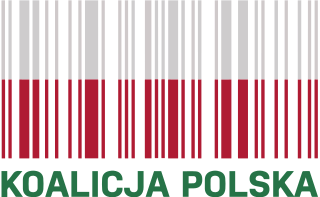
The Polish Coalition is a political alliance in Poland. It is led by the Polish People's Party.

Dariusz Joński is a Polish politician and local government official who has been serving as a member of the Sejm since 2019.

The New Left is a social-democratic political party in Poland. It is positioned on the centre-left on the political spectrum. Its leaders are Włodzimierz Czarzasty and Robert Biedroń.

Jolanta Maria Banach is a Polish politician, teacher, member of the 2nd, 3rd and 4th Sejm terms, 2001-2003 Secretary of State in the Ministry of Labor and Social Policy of Poland, and 2003-2004 Secretary of State in the Ministry of Economy, Labor and Social Policy of Poland.
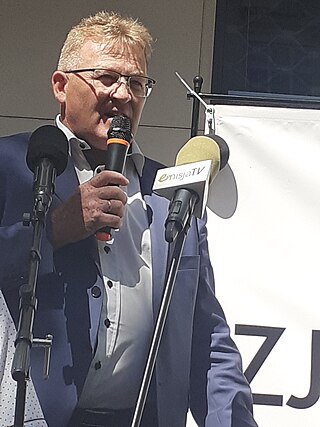
Wacław Klukowski is a Polish politician, government official, and farmer who served as a member of the Sejm of the Republic of Poland during the fourth convocation. He was also a councilor in the West Pomeranian Voivodeship.



